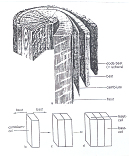4. THREE EXAMPLES
In editing complicated graphics, the draughtsperson should look for the
inkprint picture's meaning, and render it in the most simple and/or
clearest way to a blind reader.
For instance take a look at the transverse section through a tree trunk.
In inkprint the different elements have been fanned out: one wonders what
kind of impression the faithful copy will make on a blind reader. Do
trees look like that? A less complicated, more realistic rendering
of the material will make more sense.

- Tree trunk
- Faithful Copy
(ca 70K)
- Good
(ca 65K)
- Better
(ca 80K)
In the cell mitosis drawings I wonder if drawing a cell
spatially will be very useful: representing a cell by a rectangle will
make the drawing far easier to read. Also note the addition of the word
'mitosis' at the arrows.
- Cell Mitosis
- Faithful Copy
(ca 60K)
- Better
(ca 50K)
- Two stomach drawings look alright at first glance, but the
second one will actually be much clearer to the blind reader.
- wrong (ca 65K)
- right (ca 70K)
I'll list the defects:
- 1. title
- The title is missing. To find out what's in this drawing the
reader will have to look it up in the text volume, or he'll have to
infer it from the names in the drawing. The small addition 'The
stomach' will greatly enhance this drawing's value.
- 2. figure number
- The figure number is split over two lines, 11.11 in the first
line, A in the sixth. Why not simply fig.11.11-A in the first line?
- 3. spatial elements
- The stomach's entrance and exit are drawn spatially, an ellipsis
and an arc: will this make sense to the reader? What will the
ellipsis mean to him? In the second drawing it is immediately clear
what the stomach's openings are.
And besides, the drawing is of a section through: not spatial, not
the stomach taken out, so representing entrance and exit as openings
makes more sense.
- 4. hatching
- A hatch is meant to show something's extent. In the first
drawing the big dots are so far apart that the reader might easily
gather that they are meant to represent something like holes or
moles. Ideally hatch elements should not be individually
discernible.
- 5. arrows
- What exactly do arrows point at? Isn't there a choice in 2-3A at
the arrows indicating duodenum and esophagus? Placing one or two
characters in the right place is unequivocal, leaves no room for
doubt. Sometimes an arrow is the only way of identifying an element,
but I think they should be used sparingly.
- 6. point 6
- There is no need for point 6 in biology.
go to first page, previous
page or next page
© 1989, 2002 Marco Schuffelen All rights reserved
Questions? Comments? email
me
Last modified: Thu May 15 10:27:35 PDT 1989

